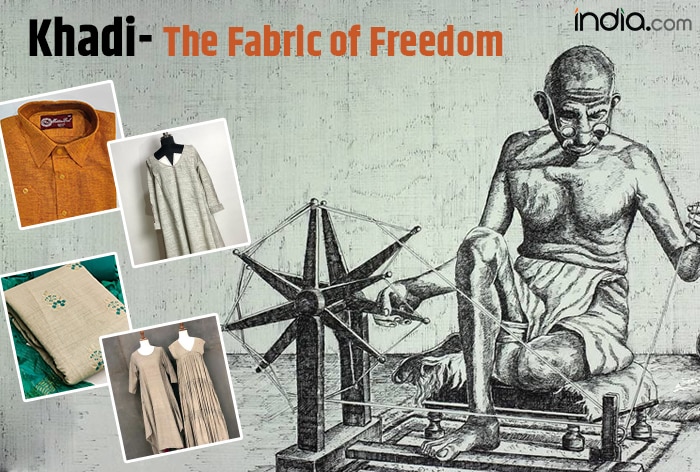Mahatma Gandhi’s Swadeshi movement highlighted the importance of wearing Khadi. From what was ascribed as a poor man’s fabric, today it has found its space in the wardrobe of the elites.

If we have the ‘khadi spirit’ in us, we would surround ourselves with simplicity in every walk of life. The ‘khadi spirit’ means illimitable patience. – Mahatma Gandhi
It’s been nearly seven decades post-independence but the symbols of rebellion and protest still ring large in our hearts. Mohandas Karamchand Gandhi was an advocate, a leader, a peacemaker and amongst everything else, he also brought on a force of change in fashion. Accredited to be spinning tales of peace, Gandhi also had a major role to play in spinning the charkha for fashion. Clad in a white khadi shawl and dhoti, with a stick in his hand and round glasses on his face, Bappu walked the march of Independence. Everyone got something out of it and the fashion industry got khadi.
Khadi is a coarse, sustainable textile material that is not just a piece of cloth, but it is a symbol of freedom, rebellion and the plight of a common person.
It was in the 1980s and early 90s when khadi found another world out of government, it got its place in the fashion realm. In 1989, the first khadi fashion show emporium was held in Mumbai by Khadi and Village Industries Commission (KVIC). In 1990, fashion designer Ritu Beri showcased her first khadi collection at a show that was held at a craft museum in Delhi.
HISTORY OF KHADI
To start from the beginning, khadi is one of the ancient fabrics that has been sitting on a weaver’s table over a thousand years and counting. The word khadi is derived from “Khaddar“, a term used for the hand-spun fabric. Majorly made from cotton, today it is also made from silk and woollen yarns. Khadi is a versatile fabric that is rugged in texture but very comfortable. It will keep one cool during the summer, and warm during winters.
Khadi’s Link With Indian Independence
Gandhiji promoted the use of Swadeshi products and urged boycotting foreign goods. In no time khadi became popular as the fabric of nationalism, and was said to be woven with ‘the threads of Swaraj’. Thus, the khadi movement was established for social and economic reasons. The essence of this movement lies in Gandhiji’s understanding of the fabric as something that could uplift the masses.
JOURNEY OF KHADI
During the struggle for independence Khadi was promoted by Gandhiji. Eventually, with more mechanised forms of textile production, cotton production, the essence died down with time. Years later, it was once again revived by the government Khadi and Village Industries Commission (KVIC) was set up that helped to boost the production, help the artisans to get their fabrics to the market. Majorly it is responsible for the planning, promotion, organization, and implementation of programs for the development of khadi in rural areas with the coordination of other agencies to enhance rural development wherever necessary.
As per KVIC data, in the year 2022-2023, it generated 9,54,000 employment. And today, 80 per cent of the artisans working on khadi are women.
WHY IS KHADI SO COSTLY?
It all began with a simple white coloured cloth that has now evolved into quirky styles, designs and mixed with other fabrics as well. Today, there is a lot more awareness about the cloth, today it has been commercialised a lot more. The commercialisation and globalisation of the cloth has allowed it to find a space in the closets of the elite.
Several designers experiment with khadi in the forms of sarees, suits, jackets. With luxury fashion designers taking on the baton, there is a reason why the price tags fo not gel well with everyone’s wallet. Not to forget that khadi is hand-woven fabric that requires more physical and emotional investment adding on to the price.
In the contemporary era, Khadi is known to be bit costlier. Speaking exclusively with india.com, Manoj Kumar, Chairman, KVIC, Govt of India, said that, ” Khadi har tareeke ke price mai hai, Sabke liye khadi uplabdh rahe yahi humari koshish hai. Hum khadi ko adhunik bana rahe iska yeh matlab nhi kiy who sab ke liye uplabdh nhi hoga. (We are modernising khadi for today’s youth but that does not mean it will not be available for common people. We have khadi available in different variety at different prices).”
However, he further explained that pricing differs from market area and city space. Kumar added, ” City mai price matter nhi karta…(price does not matter in the city).” He elaborated that when people know that the cloth is sustainable, is a good material for the body, people often do not mind in investing in it because they also know that the money will go the poor artisans.
Today, khadi has been branded globally, what started from a freedom march to crafts emporiums it reached the Lakme Fashion Week and continues to make appearances in more such contemporary and global arena. It is no more just a political jacket but a global fashion statement.
